
Buddhist Charms

Buddhism in China
Buddhism originated in India
and spread to China during the Han Dynasty beginning in the
first century AD.
Mahayana Buddhism became the dominant school in China and, together with Confucianism and Daoism (Taoism), played an important role in shaping Chinese history during the following centuries.
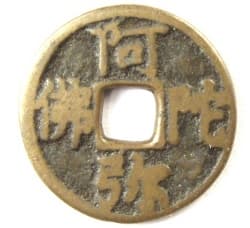 The
Mahayana texts offered those seeking salvation the possibility
of sudden enlightenment through the assistance of Buddhas and
Bodhisattvas.
The
Mahayana texts offered those seeking salvation the possibility
of sudden enlightenment through the assistance of Buddhas and
Bodhisattvas.
One of the most prominent sects to evolve in China was the Pure Land sect (jingtuzong 净土宗) which taught that enlightenment (i.e. rebirth in the Western Paradise or Pure Land) could be achieved by recitation of the name of the Amitābha Buddha (Amida Buddha).
Because chanting the name of the Buddha was a simple ritual to achieve enlightenment, the Pure Land sect became especially popular among the masses throughout China.
This Buddhist temple coin, which is discussed in more detail below, bears the inscription A Mi Tuo Fo which is the Chinese name for the Amitābha Buddha (Amida Buddha).
Regarding a charm with the inscription A Mi Tuo Fo written in Sanskrit, please see a Chinese Buddhist Charm with Sanskrit Characters.
Buddhist Temple Coins and
Charms
Mahayana Buddhism became the dominant school in China and, together with Confucianism and Daoism (Taoism), played an important role in shaping Chinese history during the following centuries.
 The
Mahayana texts offered those seeking salvation the possibility
of sudden enlightenment through the assistance of Buddhas and
Bodhisattvas.
The
Mahayana texts offered those seeking salvation the possibility
of sudden enlightenment through the assistance of Buddhas and
Bodhisattvas.One of the most prominent sects to evolve in China was the Pure Land sect (jingtuzong 净土宗) which taught that enlightenment (i.e. rebirth in the Western Paradise or Pure Land) could be achieved by recitation of the name of the Amitābha Buddha (Amida Buddha).
Because chanting the name of the Buddha was a simple ritual to achieve enlightenment, the Pure Land sect became especially popular among the masses throughout China.
This Buddhist temple coin, which is discussed in more detail below, bears the inscription A Mi Tuo Fo which is the Chinese name for the Amitābha Buddha (Amida Buddha).
Regarding a charm with the inscription A Mi Tuo Fo written in Sanskrit, please see a Chinese Buddhist Charm with Sanskrit Characters.
Buddhist Temple Coins and
Charms
Because Buddhist
temples in China had the capability of casting bells
and other bronze objects, it was easy for them to also
cast bronze coins to commemorate special occasions such as
the dedication of new structures.
These "temple coins" were cast in very small numbers and were not meant for circulation as legal currency.
They tend to be very small in size and the majority were cast during the Yuan Dynasty (1271-1368 AD).
In addition to temple coins, there are also Buddhist charms. Most of these charms have a Buddhist inscription on the obverse side with Buddhist symbols or a depiction of a Buddha, bodhisattva, or Buddhist sage on the reverse side.
An example of a Buddhist charm is discussed below.
Buddhist charms began to appear in the period after the Southern Dynasties (420-589 AD) and Northern Dynasties (386-581 AD) and then continued to be cast in the dynasties that followed.
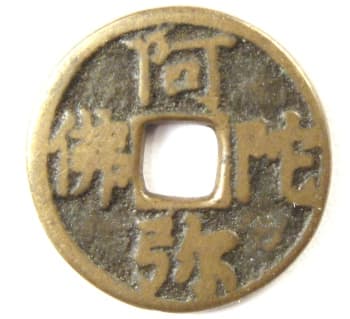
This is an example of a Chinese temple coin most probably cast during the Yuan Dynasty (1271-1368 AD).
The inscription on the obverse is read top to bottom and right to left as a mi tuo fo (阿弥陀 佛) which, as explained above, refers to the the Amida Buddha and is a common Buddhist blessing and greeting meaning "may Buddha protect you" or "take refuge in the Buddha".
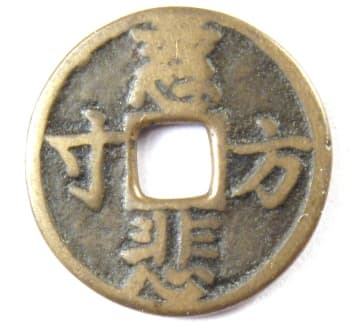 The reverse side
has the four character inscription ci bei fang cun
(慈悲方寸).
The reverse side
has the four character inscription ci bei fang cun
(慈悲方寸).
Ci bei (慈 悲) means "compassionate". (Ci 慈 is an ancient Chinese word for "mother" and is also the first of the "Three Treasures" (san bao 三宝) of Daoism (Taoism).)
In Chinese, a cun (寸) is a traditional measure of length equal to one-tenth of a Chinese foot (chi 尺). The measure was originally derived from the width of the thumb at the knuckle, which is approximately one inch. Fang means (方) "square".
Fang cun (方寸) literally means a "square inch". However, the expression "square inch" refers to the "mind" or "heart" which the Chinese believe is situated in the "square inch" between the eyebrows.
The inscription can thus be interpreted to mean "compassionate heart".
As is typical of most temple coins, this example is quite small. The coin is only 15.2 mm in diameter and has a weight of just 1.4 grams.
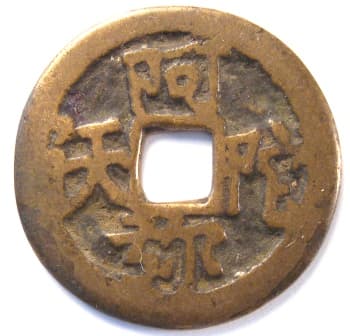
This is another Buddhist charm with the inscription a mi tuo fo (阿 弥陀佛) meaning "may Buddha protect you".
You may notice that that the fo (佛) character meaning "Buddha" is written differently. This is actually a "variant" or alternative way of writing the character.
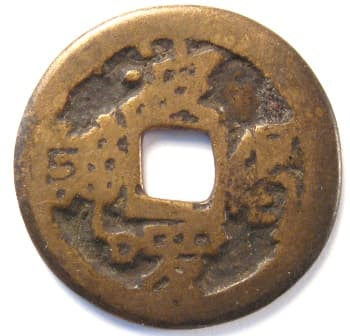 The
reverse side of the charm has an inscription taken
from the "Heart Sutra" (xinjing 心经) which is probably the
most famous of all Mahayana Buddhist scriptures.
The
reverse side of the charm has an inscription taken
from the "Heart Sutra" (xinjing 心经) which is probably the
most famous of all Mahayana Buddhist scriptures.
The "Heart Sutra" is believed to have been written sometime around 350 BC in India. The sutra reveals the "heart" or main tenets of Buddha's teachings. It explains the source of suffering and the path to liberation in a concise yet beautifully expressed manner.
The original Sanskrit was translated into Chinese by Xuanzang (玄奘 602-664 AD), the famous Chinese Buddhist monk who traveled to India. The popular Ming Dynasty novel "Journey to the West" (xi you ji 西游记) is based on his adventures.
The Heart Sutra begins with a reference to the Avalokiteśvara Bodhisattva who is known in China as Guanyin 观 音 (see charm below).
The inscription on the charm reads bo luo jie di (波 罗揭谛) and is part of the mantra found at the very end of the Heart Sutra. A mantra consists of words meant to be spoken aloud. The Chinese is actually a Romanized version of the Tibetan pronunciation of the mantra because the Tibetan pronunciation is considered to more closely approximate the sound of the original Sanskrit.
The inscription is taken from this part of the mantra:
揭谛揭谛波罗揭谛
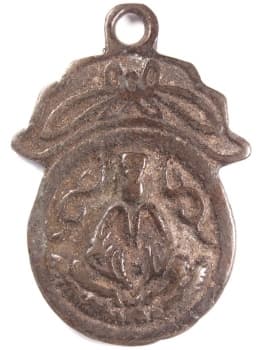
The Buddhist charm at the left, dating from the Qing Dynasty, is commonly referred to by the Chinese as a "Guanyin" (Kwan Yin, Kuan Yin) pendant charm.
Guanyin (Kuan-yin, Kwan-yin 观音), known as the male Avalokiteśvara in India, is usually depicted as a female in China and is recognized by all Chinese for her compassion and kindness.
Guanyin is a bodhisattva which means she has attained enlightenment but has refrained from entering nirvana until all beings have also attained enlightenment.
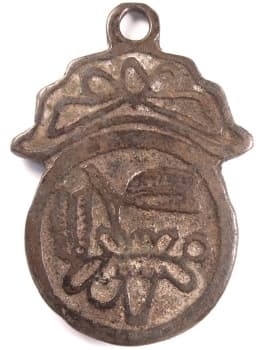 The reverse side
of the charm displays two important Buddhist symbols.
The reverse side
of the charm displays two important Buddhist symbols.
A lotus, the traditional symbol of Buddha, can be seen on the lower half of the charm.
What is most interesting about this charm, however, are the plantain or banana leaves shown above and to the left of the lotus.
The plantain (bajiao 芭蕉) is not usually associated with Guanyin but rather with Vanavasa.
Vanavasa is believed to be one of the original disciples of Buddha and is included in the group known in China as the "Eighteen Lohans" (十八罗 汉). A lohan (罗汉,啊罗汉) or arhat is a Buddhist who has attained nirvana.
Buddhist legend describes Vanavasa as having been born amidst the rustling sounds of plantain (banana) leaves on a rainy night. As a Buddhist monk, he also liked to preach under plantain trees. For these reasons, he is referred to as the "Plantain Lohan".
So, while the Chinese have historically ascribed this charm to Guanyin, it may actually be a charm associated with Vanavasa, the "Plantain Lohan".
This charm is also distinctive in that it was cast in high relief. It has a length of 62 mm and a maximum width of 42 mm.
The charm displayed here is unique in that it displays both Buddhist and Daoist (Taoist) characteristics.
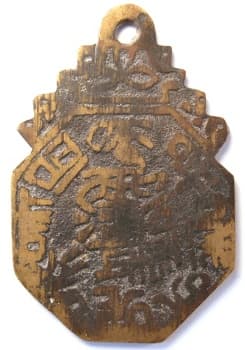 At the very center of the charm, and
shown below, is a large and interesting character
written in what is known as Daoist magic
writing and which is discussed in detail at Daoist Charms.
At the very center of the charm, and
shown below, is a large and interesting character
written in what is known as Daoist magic
writing and which is discussed in detail at Daoist Charms.
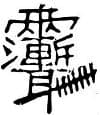
There is a category of Chinese charms that resemble the coins of Emperor Tai Zu (1368-1398) who was the first emperor of the Ming Dynasty. These charms have the same inscription on the obverse side, hong wu tong bao (洪武通宝), as the real coins, and usually depict a scene from the emperor's early life on the reverse side.
Unlike most emperors, Emperor Tai Zu came from very humble beginnings.
Yet according to Chinese law at the time, anyone who was foolish enough to reveal such details of a living emperor would face certain death.
How, then, could such charms exist?
The reason is that these charms were not made during the lifetime of Emperor Tai Zu but only began to appear much later. The earliest examples, which provided only a limited hint into the emperor's early life such as a boy riding an ox, probably date from the middle to late Qing (Ch'ing) Dynasty (1644-1911) when the authority of the emperor and the imperial system were just beginning to breakdown.
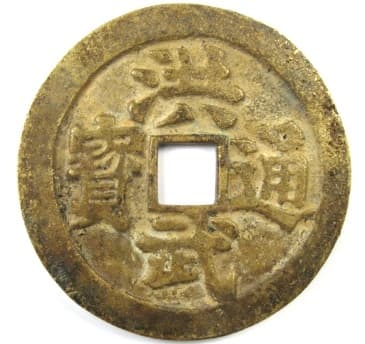
This is a later example of such a charm.
The inscription (legend) is read top to bottom and right to left as hong wu tong bao (洪武通宝) and resembles that on the coins cast during the reign of Emperor Tai Zu.
One obvious difference is the size.
This charm is very large with a diameter of 69 mm.
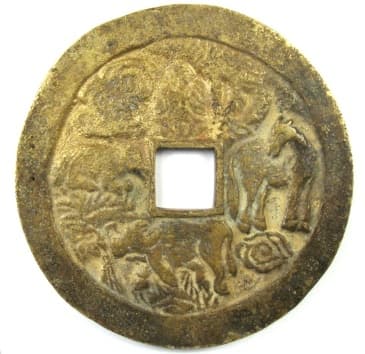
The charm needed to be large because of the complex scene of symbols depicted on the reverse side.
As mentioned above, the charm actually describes the humble early life of Emperor Tai Zu.
To the left of the square hole is a lamb and below the hole is an ox. The emperor came from a poor family of peasants and was a shepherd boy when he was very young.
Above the hole is depicted a Buddhist monk seated on a lotus throne. The emperor lived for a time at a Buddhist monastery when he was young.
On each side of the monk are Buddhist symbols. To the left is an "auspicious cloud" and to the right is a bodhi tree. The bodhi tree was the tree under which the Buddha (Siddhartha Gautama or Gautama Buddha), the spiritual founder of Buddhism, achieved enlightenment.
To the right of the square hole is a horse. The horse symbolizes the Mongols whose culture strongly associated with the horse. The Mongols were the leaders of the Yuan Dynasty under which the Chinese people and the future emperor were living at the time.
The future emperor joined local rebels who were fighting against the cruelty and injustices of the authorities. With his leadership and warrior abilities, he eventually led the rebellion in successfully defeating the Mongol army. In so doing, the Yuan Dynasty was overthrown and he established the Ming Dynasty (1368-1644 AD) with himself as its first emperor.
As mentioned earlier, it would not have been possible to cast and circulate such a graphic depiction of the life of a Chinese emperor during the imperial period without facing certain death. Only during the later Qing Dynasty (1644-1911) would the first charms depicting such scenes start to appear.
As best as can be determined, this particular charm, with its very detailed depiction of the emperor's humble beginnings, did not make an appearance until after the collapse of the Qing Dynasty and the imperial system in 1911. To avoid punishment, the Chinese apparently dared to circulate these more explicit charms only after the establishment of the Republic in 1912.
The reason these charms became popular with the Chinese masses is because they represented the hope that a person with very humble beginnings could grow up to be emperor. Emperor Tai Zu was a person who had come from a poor peasant family, had experienced the loss of his parents at an early age, had begged for food, had worked as a shepherd boy, and had lived at a Buddhist monastery. He saw the injustices his people were suffering under a dynasty that was ruled by foreigners. He relied on his own abilities and talents to eventually lead the military revolt that overthrew the Yuan Dynasty and then went on to establish a new Chinese dynasty with himself as emperor.
The life of Emperor Tai Zu inspired many common Chinese to believe that they and their children could also achieve success, in spite of humble beginnings, and this is a major reason for the popularity of charms displaying the period title hong wu.
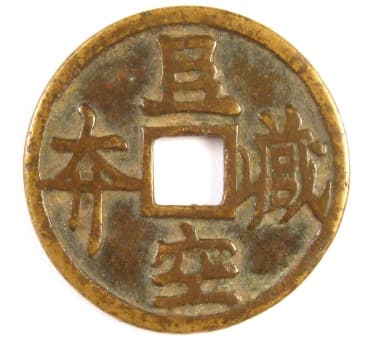
At the left is an example of a Buddhist charm cast in Japan but frequently found in China as was the case with this specific charm.
The inscription is written in Chinese characters and is read top to bottom and right to left as qie kong zang qi (且空藏弃).
Qie kong zang qi refers to the Ākāśagarbha Bodhisattva known in Japan as Kokūzō Bosatsu.
In China, the Ākāśagarbha Bodhisattva (Buddha) is known xu kong zang fo (虚空藏佛).
The Ākāśagarbha Bodhisattva is one of the eight great bodhisattvas of Buddhism. A bodhisattva is an "enlightened being" who wants to use compassion and wisdom to help others become liberated from the endless cycle of birth, rebirth and suffering.
Kūkai (Kōbō-Daishi) was a Buddhist who, after studying in China at Chang'an (长安) during the Tang Dynasty (618-907 AD), established a major sect of esoteric Buddhism in Japan during the Heian period (794-1185 AD) known as Shingon ("True Word") Buddhism. One of his favorite mantras or chants was a praise of the Ākāśagarbha Bodhisattva as represented by this charm.
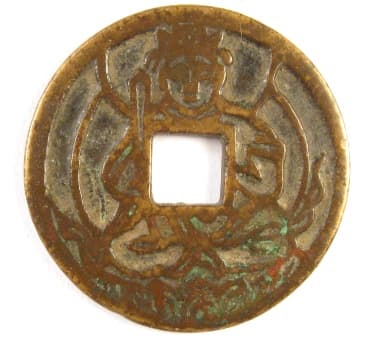
The reverse side of the charm is a depiction of the Ākāśagarbha Bodhisattva.
These charms were reportedly cast during the years 1736-1740 in Japan and were carried by Japanese Buddhists traveling to China.
The charm has a diameter of 26 mm and weight of 5.4 grams.
These "temple coins" were cast in very small numbers and were not meant for circulation as legal currency.
They tend to be very small in size and the majority were cast during the Yuan Dynasty (1271-1368 AD).
In addition to temple coins, there are also Buddhist charms. Most of these charms have a Buddhist inscription on the obverse side with Buddhist symbols or a depiction of a Buddha, bodhisattva, or Buddhist sage on the reverse side.
An example of a Buddhist charm is discussed below.
Buddhist charms began to appear in the period after the Southern Dynasties (420-589 AD) and Northern Dynasties (386-581 AD) and then continued to be cast in the dynasties that followed.
"A Mi Tuo Fo"
One of the most common
inscriptions found on Chinese Buddhist temple coins is
"a mi tuo fo"
(阿弥陀佛). "A mi
tuo fo", sometimes pronounced "e mi tuo fo", is
the Chinese pronunciation for the Sanskrit name of the
Amitābha Buddha (Amida Buddha). The
"a mi tuo" is
the transliteration of the Sanskrit word "Amida" which
means "boundless" (wuliang
无量). "Fo"
is the Chinese word for "Buddha".
Amitabha is the name of a specific Buddha known as the Buddha of Infinite Light. He vowed to forgo nirvana until all beings were able to join him.
In Chinese, "a mi tuo fo" therefore means the "boundless" or "immeasurable" Buddha. This is a reference to Pure Land Buddhism where the Buddha is "immeasurably" bright, everlasting and immeasurably "pure".
Over time, however, the expression "a mi tuo fo" gradually evolved into a very common blessing and greeting meaning "may Buddha protect", "may Buddha preserve us" and "take refuge in the Buddha".
Amitabha is the name of a specific Buddha known as the Buddha of Infinite Light. He vowed to forgo nirvana until all beings were able to join him.
In Chinese, "a mi tuo fo" therefore means the "boundless" or "immeasurable" Buddha. This is a reference to Pure Land Buddhism where the Buddha is "immeasurably" bright, everlasting and immeasurably "pure".
Over time, however, the expression "a mi tuo fo" gradually evolved into a very common blessing and greeting meaning "may Buddha protect", "may Buddha preserve us" and "take refuge in the Buddha".
Buddhist Temple Coins

This is an example of a Chinese temple coin most probably cast during the Yuan Dynasty (1271-1368 AD).
The inscription on the obverse is read top to bottom and right to left as a mi tuo fo (阿弥陀 佛) which, as explained above, refers to the the Amida Buddha and is a common Buddhist blessing and greeting meaning "may Buddha protect you" or "take refuge in the Buddha".
 The reverse side
has the four character inscription ci bei fang cun
(慈悲方寸).
The reverse side
has the four character inscription ci bei fang cun
(慈悲方寸).Ci bei (慈 悲) means "compassionate". (Ci 慈 is an ancient Chinese word for "mother" and is also the first of the "Three Treasures" (san bao 三宝) of Daoism (Taoism).)
In Chinese, a cun (寸) is a traditional measure of length equal to one-tenth of a Chinese foot (chi 尺). The measure was originally derived from the width of the thumb at the knuckle, which is approximately one inch. Fang means (方) "square".
Fang cun (方寸) literally means a "square inch". However, the expression "square inch" refers to the "mind" or "heart" which the Chinese believe is situated in the "square inch" between the eyebrows.
The inscription can thus be interpreted to mean "compassionate heart".
As is typical of most temple coins, this example is quite small. The coin is only 15.2 mm in diameter and has a weight of just 1.4 grams.

This is another Buddhist charm with the inscription a mi tuo fo (阿 弥陀佛) meaning "may Buddha protect you".
You may notice that that the fo (佛) character meaning "Buddha" is written differently. This is actually a "variant" or alternative way of writing the character.
 The
reverse side of the charm has an inscription taken
from the "Heart Sutra" (xinjing 心经) which is probably the
most famous of all Mahayana Buddhist scriptures.
The
reverse side of the charm has an inscription taken
from the "Heart Sutra" (xinjing 心经) which is probably the
most famous of all Mahayana Buddhist scriptures. The "Heart Sutra" is believed to have been written sometime around 350 BC in India. The sutra reveals the "heart" or main tenets of Buddha's teachings. It explains the source of suffering and the path to liberation in a concise yet beautifully expressed manner.
The original Sanskrit was translated into Chinese by Xuanzang (玄奘 602-664 AD), the famous Chinese Buddhist monk who traveled to India. The popular Ming Dynasty novel "Journey to the West" (xi you ji 西游记) is based on his adventures.
The Heart Sutra begins with a reference to the Avalokiteśvara Bodhisattva who is known in China as Guanyin 观 音 (see charm below).
The inscription on the charm reads bo luo jie di (波 罗揭谛) and is part of the mantra found at the very end of the Heart Sutra. A mantra consists of words meant to be spoken aloud. The Chinese is actually a Romanized version of the Tibetan pronunciation of the mantra because the Tibetan pronunciation is considered to more closely approximate the sound of the original Sanskrit.
The inscription is taken from this part of the mantra:
揭谛揭谛波罗揭谛
jie di jie di bo luo jie di
(Chinese)
ga te ga te pa ra ga te (Sanskrit)
ga te ga te pa ra ga te (Sanskrit)
The "pa ra ga te"
(paragate)
translates as
"gone beyond"
which means in the progressive path to the
perfection of wisdom and the attainment of
enlightenment, it is necessary for one to have
"gone beyond".
The charm has a diameter of 24 mm and a weight of 3.5 grams.
The charm has a diameter of 24 mm and a weight of 3.5 grams.
Chinese Buddhist Charms

The Buddhist charm at the left, dating from the Qing Dynasty, is commonly referred to by the Chinese as a "Guanyin" (Kwan Yin, Kuan Yin) pendant charm.
Guanyin (Kuan-yin, Kwan-yin 观音), known as the male Avalokiteśvara in India, is usually depicted as a female in China and is recognized by all Chinese for her compassion and kindness.
Guanyin is a bodhisattva which means she has attained enlightenment but has refrained from entering nirvana until all beings have also attained enlightenment.
 The reverse side
of the charm displays two important Buddhist symbols.
The reverse side
of the charm displays two important Buddhist symbols.A lotus, the traditional symbol of Buddha, can be seen on the lower half of the charm.
What is most interesting about this charm, however, are the plantain or banana leaves shown above and to the left of the lotus.
The plantain (bajiao 芭蕉) is not usually associated with Guanyin but rather with Vanavasa.
Vanavasa is believed to be one of the original disciples of Buddha and is included in the group known in China as the "Eighteen Lohans" (十八罗 汉). A lohan (罗汉,啊罗汉) or arhat is a Buddhist who has attained nirvana.
Buddhist legend describes Vanavasa as having been born amidst the rustling sounds of plantain (banana) leaves on a rainy night. As a Buddhist monk, he also liked to preach under plantain trees. For these reasons, he is referred to as the "Plantain Lohan".
So, while the Chinese have historically ascribed this charm to Guanyin, it may actually be a charm associated with Vanavasa, the "Plantain Lohan".
This charm is also distinctive in that it was cast in high relief. It has a length of 62 mm and a maximum width of 42 mm.
The charm displayed here is unique in that it displays both Buddhist and Daoist (Taoist) characteristics.
 At the very center of the charm, and
shown below, is a large and interesting character
written in what is known as Daoist magic
writing and which is discussed in detail at Daoist Charms.
At the very center of the charm, and
shown below, is a large and interesting character
written in what is known as Daoist magic
writing and which is discussed in detail at Daoist Charms.
The Buddhist
characteristics of the charm are revealed in the
inscription that surrounds this Daoist magic
character.
Starting at the top and going counter-clockwise along the rim are eight characters of which the key six characters are as follows:
Starting at the top and going counter-clockwise along the rim are eight characters of which the key six characters are as follows:
唵嘛呢叭咪吽
These six
characters compose Buddhism's most famous
mantra (prayer) which is said to contain all
the teachings of Buddha.
The Avalokiteśvara Bodhisattva of India can take on many forms. He can be male, female, have four arms or a thousand arms, etc. As a bodhisattva, Avalokiteśvara has delayed becoming an enlightened Buddha so that he can deliver others from suffering. No matter what form he takes, he is the bodhisattva of compassion.
In China and Japan, the Avalokiteśvara Bodhisattva has taken on the form known as Guanyin (Kuan-yin, Kwan-yin 观音). In Tibet, he is known as Chenrezig.
The six-character Buddhist mantra (唵嘛呢叭咪吽) is pronounced differently depending on the language. In Chinese (Mandarin) the characters are pronounced an ma ni ba mi hong. In Tibetan, the characters are pronounced om ma ni pad me hum as can be heard in this recording by a Tibetan monk.
Buddhists believe that chanting this "Six Word Mantra" will bring forth the attention and blessings of Guanyin/Chenrezig. It is appropriate that a mantra serves as the link to the Bodhisattva since the root meaning of Avalokiteśvara is "he who observes the sounds of the world".
This is also the mantra written on Tibetan prayer wheels (Mani wheel).
It is impossible to provide a simple yet accurate translation of the mantra but it is sometimes translated as "Behold! The jewel in the lotus!"
This charm has a length of 49.5 mm, a width of 32 mm and a weight of 7.6 grams.
The Avalokiteśvara Bodhisattva of India can take on many forms. He can be male, female, have four arms or a thousand arms, etc. As a bodhisattva, Avalokiteśvara has delayed becoming an enlightened Buddha so that he can deliver others from suffering. No matter what form he takes, he is the bodhisattva of compassion.
In China and Japan, the Avalokiteśvara Bodhisattva has taken on the form known as Guanyin (Kuan-yin, Kwan-yin 观音). In Tibet, he is known as Chenrezig.
The six-character Buddhist mantra (唵嘛呢叭咪吽) is pronounced differently depending on the language. In Chinese (Mandarin) the characters are pronounced an ma ni ba mi hong. In Tibetan, the characters are pronounced om ma ni pad me hum as can be heard in this recording by a Tibetan monk.
Buddhists believe that chanting this "Six Word Mantra" will bring forth the attention and blessings of Guanyin/Chenrezig. It is appropriate that a mantra serves as the link to the Bodhisattva since the root meaning of Avalokiteśvara is "he who observes the sounds of the world".
This is also the mantra written on Tibetan prayer wheels (Mani wheel).
It is impossible to provide a simple yet accurate translation of the mantra but it is sometimes translated as "Behold! The jewel in the lotus!"
This charm has a length of 49.5 mm, a width of 32 mm and a weight of 7.6 grams.
There is a category of Chinese charms that resemble the coins of Emperor Tai Zu (1368-1398) who was the first emperor of the Ming Dynasty. These charms have the same inscription on the obverse side, hong wu tong bao (洪武通宝), as the real coins, and usually depict a scene from the emperor's early life on the reverse side.
Unlike most emperors, Emperor Tai Zu came from very humble beginnings.
Yet according to Chinese law at the time, anyone who was foolish enough to reveal such details of a living emperor would face certain death.
How, then, could such charms exist?
The reason is that these charms were not made during the lifetime of Emperor Tai Zu but only began to appear much later. The earliest examples, which provided only a limited hint into the emperor's early life such as a boy riding an ox, probably date from the middle to late Qing (Ch'ing) Dynasty (1644-1911) when the authority of the emperor and the imperial system were just beginning to breakdown.

This is a later example of such a charm.
The inscription (legend) is read top to bottom and right to left as hong wu tong bao (洪武通宝) and resembles that on the coins cast during the reign of Emperor Tai Zu.
One obvious difference is the size.
This charm is very large with a diameter of 69 mm.

The charm needed to be large because of the complex scene of symbols depicted on the reverse side.
As mentioned above, the charm actually describes the humble early life of Emperor Tai Zu.
To the left of the square hole is a lamb and below the hole is an ox. The emperor came from a poor family of peasants and was a shepherd boy when he was very young.
Above the hole is depicted a Buddhist monk seated on a lotus throne. The emperor lived for a time at a Buddhist monastery when he was young.
On each side of the monk are Buddhist symbols. To the left is an "auspicious cloud" and to the right is a bodhi tree. The bodhi tree was the tree under which the Buddha (Siddhartha Gautama or Gautama Buddha), the spiritual founder of Buddhism, achieved enlightenment.
To the right of the square hole is a horse. The horse symbolizes the Mongols whose culture strongly associated with the horse. The Mongols were the leaders of the Yuan Dynasty under which the Chinese people and the future emperor were living at the time.
The future emperor joined local rebels who were fighting against the cruelty and injustices of the authorities. With his leadership and warrior abilities, he eventually led the rebellion in successfully defeating the Mongol army. In so doing, the Yuan Dynasty was overthrown and he established the Ming Dynasty (1368-1644 AD) with himself as its first emperor.
As mentioned earlier, it would not have been possible to cast and circulate such a graphic depiction of the life of a Chinese emperor during the imperial period without facing certain death. Only during the later Qing Dynasty (1644-1911) would the first charms depicting such scenes start to appear.
As best as can be determined, this particular charm, with its very detailed depiction of the emperor's humble beginnings, did not make an appearance until after the collapse of the Qing Dynasty and the imperial system in 1911. To avoid punishment, the Chinese apparently dared to circulate these more explicit charms only after the establishment of the Republic in 1912.
The reason these charms became popular with the Chinese masses is because they represented the hope that a person with very humble beginnings could grow up to be emperor. Emperor Tai Zu was a person who had come from a poor peasant family, had experienced the loss of his parents at an early age, had begged for food, had worked as a shepherd boy, and had lived at a Buddhist monastery. He saw the injustices his people were suffering under a dynasty that was ruled by foreigners. He relied on his own abilities and talents to eventually lead the military revolt that overthrew the Yuan Dynasty and then went on to establish a new Chinese dynasty with himself as emperor.
The life of Emperor Tai Zu inspired many common Chinese to believe that they and their children could also achieve success, in spite of humble beginnings, and this is a major reason for the popularity of charms displaying the period title hong wu.
Japanese Buddhist Charms in China

At the left is an example of a Buddhist charm cast in Japan but frequently found in China as was the case with this specific charm.
The inscription is written in Chinese characters and is read top to bottom and right to left as qie kong zang qi (且空藏弃).
Qie kong zang qi refers to the Ākāśagarbha Bodhisattva known in Japan as Kokūzō Bosatsu.
In China, the Ākāśagarbha Bodhisattva (Buddha) is known xu kong zang fo (虚空藏佛).
The Ākāśagarbha Bodhisattva is one of the eight great bodhisattvas of Buddhism. A bodhisattva is an "enlightened being" who wants to use compassion and wisdom to help others become liberated from the endless cycle of birth, rebirth and suffering.
Kūkai (Kōbō-Daishi) was a Buddhist who, after studying in China at Chang'an (长安) during the Tang Dynasty (618-907 AD), established a major sect of esoteric Buddhism in Japan during the Heian period (794-1185 AD) known as Shingon ("True Word") Buddhism. One of his favorite mantras or chants was a praise of the Ākāśagarbha Bodhisattva as represented by this charm.

The reverse side of the charm is a depiction of the Ākāśagarbha Bodhisattva.
These charms were reportedly cast during the years 1736-1740 in Japan and were carried by Japanese Buddhists traveling to China.
The charm has a diameter of 26 mm and weight of 5.4 grams.
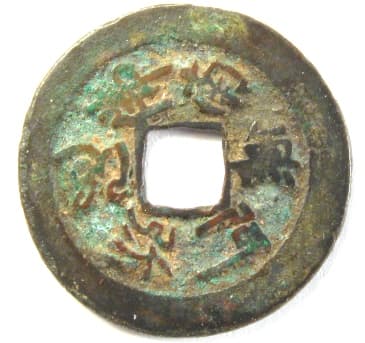 This is
another Japanese Buddhist charm found in China.
This is
another Japanese Buddhist charm found in China.The inscription, written clockwise beginning with the character at the one o'clock position, is 南无阿弥陀佛.
The first two characters 南无 (nan wu) are actually a transliteration of the Sanskrit word namah which means "to trust in". When these two Chinese characters are used in this manner the Chinese pronunciation should actually be na mo.
The last four characters 阿弥陀佛 (a mi tuo fo) is the Chinese pronunciation for the Sanskrit name of the Amitābha Buddha (Amida Buddha) as described above.
The entire inscription, therefore, has the meaning of "I put my trust in Amida Buddha".
This charm has a diameter of 24.5 mm and a weight of 3.7 grams.
*** An interesting Japanese 'daruma doll' showing Bodhidharma holding a Chinese "tai he wu zhu" coin is discussed at "Bodhidharma Holding a Wu Zhu Coin".
Return to Ancient Chinese Charms and Coins